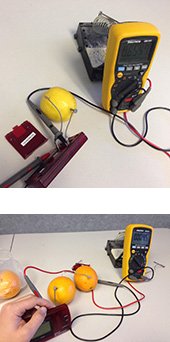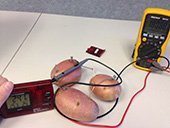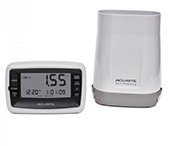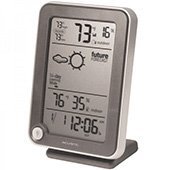How many lemons does it take to power a thermometer? We did the experiment.
How many lemons does it take to power a thermometer? We did the experiment. |
How many lemons does it take to power a thermometer? We did the experiment, find out here.Did you learn at school that you can produce electricity from common fruit and vegetables? We did and it got Daniel our Scientific Sales Consultant thinking. Could we power some of our equipment from the raw energy of a lemon, or even from some potatoes? The results we found very interesting, please read on. With Christmas coming quick we have our Christmas Weather Station flyer, check it out here. In the weather stations division we now have available a selection of the fantastic AcuRite Weather Stations from the USA, we think they will prove very popular due to their sleek and high quality design, (they certainly have blown away the competition in the USA). Do you have an experiment you would like us to perform? Let us know, just reply to this email. Until next month…Tyson Grubb | |||||||||||||||||||||||||||||||||||||||||||||||||||||||||||||||||||||||||||||||||||||||||||||||||||||||||||||||||
 Can we power a thermometer using only fruit and vegetables?For this month’s experiment we are going to determine if it is possible to power one of our IC800040R thermometer’s using fruit and vegetables. Lemons, limes, oranges, tomatoes and potatoes will be used for the basis of our batteries as they contain acid and zinc plated (galvanised nails) and copper wire will be used for terminals. The fruit and vegetables act as an acidic electrolyte which allows for the flow of ions through the medium. The acid contained within the fruits and vegetables steadily eat away at the zinc on the nail releasing spare zinc electrons. These electrons then join with spare hydrogen ions contained within the fruit/ vegetable to create hydrogen gas. If only the zinc electrode was connected, little would occur, however when a piece of conductive wire is connected between the terminals the spare zinc electrons are intent on forming hydrogen gas but find it easier to do so with the hydrogen ions surrounding the zinc terminal so electrons travel through the copper terminal to get to the zinc electrons hence creating a circuit. This flow of electrons causes the production of electricity. We are going to see if we can use this reaction to power our thermometer. Read on to find out if it worked! | |||||||||||||||||||||||||||||||||||||||||||||||||||||||||||||||||||||||||||||||||||||||||||||||||||||||||||||||||
Equipment used:
Method 
Results The IC800040R was found to require between 0.042 and 0.112mA current along with a voltage of 1.5V in order to operate when tested with the 1.5V AAA battery that it normally uses. The results for each of the voltage and current tests along with the pH tests are shown below:
The results definitively prove that you can power our IC800040R using only fruit and vegetables; however it is a condition that the current and voltage be at a level that is sufficient to keep the thermometer running. All five of the tested fruits and vegetables powered the thermometer when they were connected in series of four. It is interesting to note that the currents and voltages were fairly consistent across the board and that the fruits with higher pH’s did not produce a significant increase in current or voltage. Have your say!  Thermometer powering on with 3 potatoes; however it would drop in and out. 4 were required to keep it running. What else do you think we could have powered using only fruit and vegetables? Do you think there was a way that we could have increased the current or voltage using the same number of fruits and vegetables? Do you think using zinc and a different material would have yielded different results? Write an email to Daniel at [email protected] or give us a call on 1300 737 871. | |||||||||||||||||||||||||||||||||||||||||||||||||||||||||||||||||||||||||||||||||||||||||||||||||||||||||||||||||
| |||||||||||||||||||||||||||||||||||||||||||||||||||||||||||||||||||||||||||||||||||||||||||||||||||||||||||||||||


